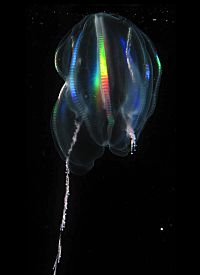Tentaculata facts for kids
Quick facts for kids Tentaculata |
|
|---|---|
 |
|
| Mertensia ovum | |
| Scientific classification | |
| Kingdom: | |
| Phylum: | |
| Class: |
Tentaculata
|
| Orders | |
|
Cestida |
|
Tentaculata is a special group of comb jellies. These amazing sea creatures are known for their unique features. They live in the ocean and are a type of invertebrate, meaning they do not have a backbone.
Contents
What Are Tentaculata?
Tentaculata are a class of animals within the phylum Ctenophora. This means they are a major group of comb jellies. They are often called "comb jellies" because they have rows of tiny, hair-like structures. These structures look like combs and help them swim through the water.
Their Amazing Tentacles
The most important thing about Tentaculata is their pair of long, feathery tentacles. These tentacles are very special. They can shrink or pull back into special pockets on their bodies. These pockets are called "ciliated sheaths." They are lined with tiny hairs that help the tentacles move in and out.
Some Tentaculata species have smaller, secondary tentacles. These are in addition to their main pair. The tentacles are covered with special sticky cells called colloblasts. These cells are like tiny glue traps. They help the comb jellies catch small prey in the water.
What Do They Eat?
Tentaculata are carnivores, which means they eat other animals. They use their sticky colloblast cells to catch tiny sea creatures. Their diet usually includes small crustaceans, larvae, and other tiny plankton. They are important predators in the ocean's food web.
Where Do They Live?
Tentaculata live in oceans all over the world. You can find them in different depths, from the surface to the deep sea. They drift through the water, using their comb rows to move around. Their transparent bodies help them blend in with the water. This makes it harder for predators to spot them.
Different Kinds of Tentaculata
There are several different groups, or orders, within the Tentaculata class. Each group has its own unique look and way of life. Some of the main orders include:
- Cestida: These comb jellies are flat and ribbon-like. They can be very long.
- Cydippida: These are more round or oval-shaped. They have two long tentacles.
- Lobata: These have special lobes or flaps around their mouths. These lobes help them catch food.
- Platyctenida: These are often flattened and live on the seafloor. They look more like flatworms than typical comb jellies.
Each of these groups shows how diverse and interesting the Tentaculata are. They all share the common feature of having those amazing tentacles.
See also
 In Spanish: Tentaculados para niños
In Spanish: Tentaculados para niños

